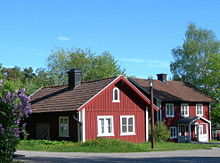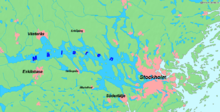Mälardalen
The Mälartal ( Swedish Mälardalen ) is the valley around the lake Mälaren in Sweden . The term is often used to refer to this part of Sweden, but there is no official definition of the term. The Mälar Valley is relatively densely populated with many of Sweden's largest cities and contains large parts of the historic Swedish heartland of Svealand .
Definitions
Mälardalen usually refers to the southwest of Uppland , South Västmanland and North Södermanland . Greater Stockholm is usually also included, sometimes even the valley around Hjälmaren with Närke .
The largest cities in the Mälar Valley are Stockholm , Södertälje , Strängnäs , Eskilstuna , Arboga , Köping , Västerås and Enköping . Sometimes Uppsala and Örebro are included as well.
The organization Mälardalsrådet , a political interest and cooperation organization of the east Swedish provincial parishes and municipalities , has as members the provincial parishes of Örebro län , Södermanland län , Stockholm län , Uppsala län , Västmanland län and a total of 56 municipalities. In this sense, the Mälar Valley is primarily to be understood as an expanded Stockholm capital region.
Mark

Many typical “Swedish” signs, such as red wooden houses, are particularly common in this region. This region is also historically marked by the many castles and manors near the capital Stockholm. In the German-speaking world, the Mälar valley is a backdrop for both literary, z. B. Gripsholm Castle by Kurt Tucholsky , as a dramatic, z. B. the Inga Lindström melodramas, works known.
dialect
The modern dialect spoken in the Ostmalar Valley and near Stockholm is often perceived as a kind of " High Swedish" in other parts of Sweden . In fact, the dialect from Westmälar Valley is clearly distinguishable from the Stockholm dialect, but the dialects of the entire region belong to Sveamål , the Svealand dialects.
See also
- The Mälardalen University in Västerås and Eskilstuna , named after the Mälar valley
- East Sweden
- Recarne
- Södertörn
- Svealand
Individual evidence
- ↑ Mälardalsrådet-Medlemmar ( Memento of the original from October 15, 2011 in the Internet Archive ) Info: The archive link was inserted automatically and has not yet been checked. Please check the original and archive link according to the instructions and then remove this notice.
- ↑ a b Flygare, Iréne (1997). Mälaren down. Utbildningsförlaget Brevskolan. Pp. 6-11. ISBN 91-574-4829-9 .


